Find out how you can use your body to worship the source of life and awaken your inner healing force.
It is a blessed day. You are in Banaras, India’s most sacred and ancient city. Your pilgrimage has reached its climax, and you are on a boat on the holy river Ganga just before dawn. Bells are ringing. Throngs are chanting mantras. Incense fills the air as thousands of butter lamps float downriver with the current. It’s a magical moment—the glowing sun opens its eye on the eastern horizon, filling the temples and palaces on the western ghat with golden rays.
Surya namaskara is one of the most complete practices of hatha yoga.
As your boat moves northward upstream, you see crowds bathing on the left bank and notice that many people are simply standing facing the sun with folded hands. Others are throwing their arms to the sky, then bending forward to kiss their knees, or prostrating and then lifting their heads like lizards on the lookout. Curious, you ask your boatman about this scene, “Oh,” he says, “these are brahmin pandits doing their morning puja (worship).”
But dig deeper, and you discover that this is where the tradition of sandhya-upasana,the dawn and twilight meditation on the sun, began. The curious postures you noticed are a salutation to the sun; surya namaskara, the yoga sun salutation series, is part of that ancient tradition.
The Benefits of Surya Namaskara
Surya namaskara is one of the most complete practices of hatha yoga. The primary intention of this series of poses is to awaken the energy of the sun that normally lies dormant at the navel center. Surya namaskara allows us to reach deep into our solar plexus and awaken and circulate the sun’s healing power to restore a radiant body and cultivate a clear, calm, and tranquil mind. With a couple of cycles of the sun salutation, you can fan your digestive fire, energize your nervous system, balance your pranic flow, activate both the lower and upper extremities, and influence your moods.
The sun salutation awakens the energy of the sun that normally lies dormant at the navel center.
Like other classic yoga asanas, the sun salutation is a gateway to entering your subtle body, tapping into your healing power, gaining vitality, and accelerating the process of rejuvenation. To derive all these benefits, however, you must take the practice beyond stretching. The spiritual dimension of surya namaskara is much more profound and fulfilling than the physical level of practice alone. When both the physical and spiritual aspects are strung together, the practice becomes Sutra Yoga—the kind of practice intended by masters like Patanjali, the compiler of the Yoga Sutra. A Sutra Yoga style of the sun salutation strings together (sutra) body, breath, mind, and soul with the healing and nurturing forces of the sun, and infuses life with serenity and inner awakening. In this way, the sun salutation becomes a complete practice of yoga, meditation, and spirituality.
A Spiritual Approach to Surya Namaskara
Here is how you take the practice of the sun salutation beyond the physical to your heart. After a minimum of three rounds of surya namaskara (12 or more is ideal), stand still with your hands folded at your heart. Close your eyes. Breathe gently, smoothly, and effortlessly.
The spiritual dimension of surya namaskara is much more profound and fulfilling than the physical level of practice alone.
For a moment, bring your attention to your navel center. Here visualize flames of fire. The pelvis is the base of the fire, and the triangular-shaped flames of fire fill the entire abdomen so the tip of the flame touches the sternum. Take three conscious natural breaths, breathing deeply, evenly, without jerks or noise, and without a pause between the inhalation and the exhalation. Then shift your attention to your heart center.
Keeping your focus at the heart center, recite the following prayer, which Agastya, the great siddha master, taught to Lord Rama:
I pray to the core of the universe, the source of life, and the embodiment of light—the rising Sun. I pray to the One who is worshipped by all living beings—the bright beings and not-so-bright beings. I pray to the Creator of Light, the Lord of the Universe, and the oldest son of the primordial teacher, the Mother Aditi.
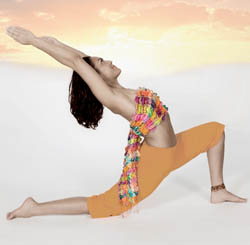 Then bring your attention back to the navel center and visualize the flame of fire all around it. The navel center constitutes the core of fire—the bright, smokeless fire resembling, both in shape and color, the radiant sun a little after sunrise. While keeping your focus at this bright inner sun, mentally repeat the seed mantra of the fire, ram (pronounced “rum”). If you are familiar with the Gayatri mantra, this is the time to remember the Gayatri mantra with your mind concentrated on the inner sun of the navel center.
Then bring your attention back to the navel center and visualize the flame of fire all around it. The navel center constitutes the core of fire—the bright, smokeless fire resembling, both in shape and color, the radiant sun a little after sunrise. While keeping your focus at this bright inner sun, mentally repeat the seed mantra of the fire, ram (pronounced “rum”). If you are familiar with the Gayatri mantra, this is the time to remember the Gayatri mantra with your mind concentrated on the inner sun of the navel center.
Yogis interested in awakening the healing power and cultivating yogic siddhis, such as intuitive diagnosis, distant healing, and clairvoyance, take this practice one step further. With the help of pranayama, they drink the rays of the sun, practice an advanced version of trataka (gazing practice), and finally, with the combined force of mind and breath, they draw the mantrically charged energy of the sun through each chakra from the base of the spine to the crown of the head. An example of such a practice uses a special version of the Gayatri mantra with visualization. This special practice of the Gayatri mantra is accompanied by the seven vyahriti, the seven utterances, which are essentially like seven logos designating the seven planes of consciousness.
To do the practice, sit in a meditation pose and mentally repeat each of the vyahritis as you bring your attention to the indicated area of the body:

Mantra
| Chakra Name
| |
| Om Bhuh | muladhara chakra | at the perineum |
| Om Bhuvah | svadishthana chakra | in the lower pelvis |
| Om Svah | manipura chakra | at the navel centerLocation |
| Om Mahah | anahata chakra | at the heart center |
| Om Janah | vishuddhi chakra | at the throat center |
| Om Tapah | ajna chakra | between the eyebrows |
| Om Satyam | sahasrara chakra | at the crown of the head |
| Om parorajase savadom | whole body |
Feel as if your whole body is filled with the light of the sun. Your body is replaced by light; you have become an embodiment of light. As time permits, meditate on that light for as long as you enjoy it. Then begin japa (mental repetition) of the Gayatri mantra.
The Poses of the Sun Salutation
Traditionally, surya namaskara is practiced at the beginning of an asana session to warm up the body, and to acknowledge the inner sun and its profound role in regulating the body. Because of its comprehensive effects, this sequence may be practiced alone as a complete asana session, perhaps with the addition of a lateral stretch, a twist, and an inverted pose.
Namaste

Step your feet under your hip joints and press them evenly into the floor. Press the hands together, draw the shoulder blades down, broaden the collar bones, and lift up through the crown of the head.
Overhead Stretch

Inhale, sweep the arms out to the side and overhead. Press down through the feet, lift the heart, and look up between the hands as you draw the shoulder blades down.
Standing Forward Bend
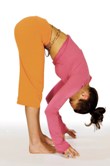
Exhale, sweep the arms out to the side, bend the knees, and fold forward from the hip joints. Lift the sit bones as you roll the thighs in and draw back the upper groin and outer hip.
Lunge
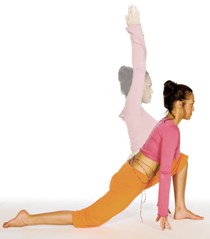
Inhale, step the right foot back. Keep the left knee square over the left ankle as you lift the heart, moving the spine toward the front of the body. Draw the thighs away from each other. Lift through the crown of the head, broaden the collar bones, draw the chin in slightly. (Alternately, press the left thigh down and away from the pelvis with the hands, or stretch the arms overhead.)
Plank Pose
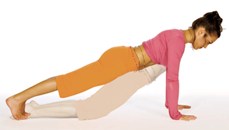
Exhale, turn the right toes under and step the left foot back, straightening the legs. (Alternately, be on your knees.) Keep the lower belly engaged and the pelvis in line with the chest. Inhale.
Eight-Point Pose

Exhale, bend the elbows, and lower the chest to the floor between the hands. Keep the pelvis off the floor and draw the shoulder blades down.
Cobra Pose

Inhale, press the hands into the floor, glide forward, and then lift the chest. Press the pelvis into the floor. Draw the shoulder blades down and lift from the back, drawing the legs down into the floor and out of the pelvis. Lengthen the back of the neck and draw the crown of the head and the toes away from each other.
Downward-Facing Dog
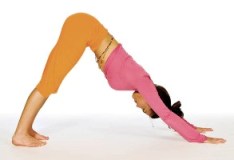
Exhale, lower the chest. Press through the shoulders up onto the hands and knees. Lift the sit bones to bring the pelvis up and back, and straighten the legs. Bend the knees or lift the heels if necessary to keep the spine neutral. Keep your weight equally distributed between the hands and the feet. Hold for a couple of breaths.
Lunge
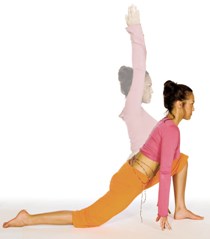
Inhale, step the right foot forward between the hands. Keep the right knee square over the ankle. Draw the thighs away from each other, lower the pelvis, and lift through the crown of the head. Broaden the collar bones, and draw the chin in slightly. (Alternately, stretch the arms overhead.)
Standing Forward Bend
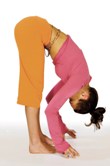
Overhead Stretch

Inhale, bend the knees and unfold from the hip joints to standing position, sweeping the arms out to the side and overhead.
Namaste

Exhale the arms out to the side. Press the palms together and the feet into the floor. Lengthen up through the crown of the head.

ABOUT Pandit Rajmani Tigunait Spiritual head of the Himalayan Institute, Pandit Tigunait is the successor of Swami Rama of the Himalayas. Lecturing and teaching worldwide for more than a quarter of a century, he is the author of fourteen books, including his autobiography Touched by Fire: The Ongoing Journey of a Spiritual Seeker, the best-selling At the Eleventh Hour: The Biography of Swami Rama of the Himalayas and a regular contributor to Yoga International. Pandit Tigunait holds two doctorates: one in Sanskrit from the University of Allahabad in India, and another in Oriental Studies from the University of Pennsylvania. Family tradition gave Pandit Tigunait access to a vast range of spiritual wisdom preserved in both the written and oral traditions. Before meeting his master, Pandit Tigunait studied Sanskrit, the language of the ancient scriptures of India, as well as the languages of the Buddhist, Jaina, and Zorastrian traditions. In 1976, Swami Rama ordained Pandit Tigunait into the 5,000-year-old lineage of the Himalayan Masters.
Δεν υπάρχουν σχόλια:
Δημοσίευση σχολίου